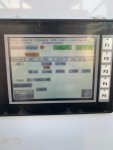Something to watch out for is the algorithm used to calculate RPM in such a system.
A really simple approach is to simply count up the number of pulses per unit time. The problem is that the number of pulses is always an integer, which means you will be high or low by a fraction of a pulse. In your system, 200 pulses in a sampling period would mean 300 RPM, 199 pulses would mean 298.5 RPM, and any speed between those that correspond to integral pulse counts will 'flicker' between the allowed values. This can cause problems if your alarm values are too tight.
-Jon


